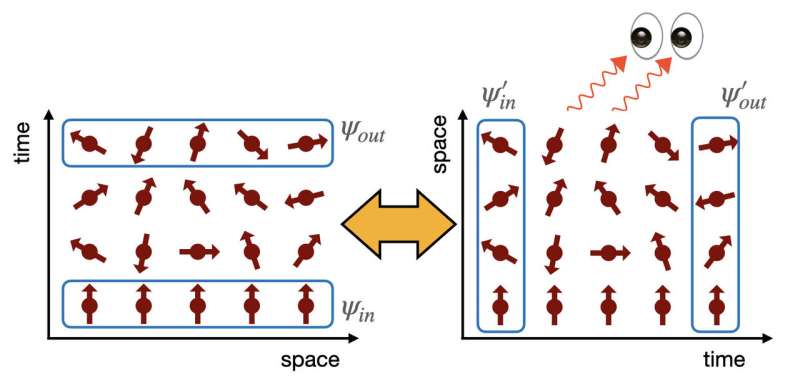March 12, 2021 feature
A protocol to explore entanglement dynamics via spacetime duality

In recent years, there have been significant advancements in the development of digital quantum computers and simulators. These emerging physical systems are opening up unprecedented possibilities for controlling and measuring a variety of quantum dynamics. As a result, some fundamental questions in many-body physics that would have previously been considered speculative and outside the realm of experimental exploration can now be examined in laboratory settings.
Researchers at Stanford University have recently carried out a study exploring the role of quantum measurements in many-body dynamics. In their paper, published in Physical Review Letters, they specifically presented a protocol that can be used to realize dynamics that include quantum measurements in quantum computers and quantum simulators, while avoiding a procedural step known as postselection.
"Measurements have a special place in quantum physics: They cause the system to abruptly 'collapse' onto one of several possible measurement outcomes, chosen at random," Matteo Ippoliti and Vedika Khemani, the two researchers who carried out the study, told Phys.org. "For instance, think of Schrodinger's cat in a 'superposition' of alive and dead in a box—as soon as the box is opened, the cat's state collapses to either alive or dead. In contrast, quantum systems that are 'left alone' evolve in a deterministic way, also known as 'unitary' dynamics."
Over the past few years, partly motivated by recent progress in the development of quantum computing devices, many researchers have started studying the interplay between quantum measurements and many-body unitary dynamics. Interestingly, they predicted that states produced by these devices would exhibit a varied set of new phenomena. Subsequently, these observations became the focus of numerous theoretical studies.
"From an experimental standpoint, the randomness of quantum measurements poses a big problem: In order to reliably make the same state (necessary to measure its properties, or to use it in applications), one must replicate the same random sequence of measurement outcomes over and over," Ippoliti and Khemani explained. "This is an exponentially rare occurrence, like tossing a coin many times and getting a straight sequence of heads, and it is not a technical limitation but rather a consequence of basic rules of quantum mechanics. This is the problem of 'postselection.'"
In order to measure entanglement in non-unitary dynamics, researchers would have to repeat an experiment many times in order to satisfy this `postselection' requirement, which would be prohibitively hard. The primary objective of the study carried out by Ippoliti and Khemani was to devise a strategy to enable the experimental realization of these dynamics without the need for postselection. They proposed that this could be achieved by exchanging the roles of space and time, leveraging an idea known as spacetime duality.
"In simple terms, imagine having a set of quantum bits (qubits) in your lab, arranged on a line, at positions one, two, etc.," Ippoliti and Khemani said. "These can be made to interact with their neighbors and thus evolve in time, describing a quantum computation. Now imagine a 'virtual' system that exists in the laboratory's time direction and evolves in the space direction—moving from qubit one to two in the lab means evolving this virtual system for one unit of time, etc."
The 'virtual evolution' of the system examined by the researchers turned out to be non-unitary, which essentially means that it includes some measurement elements. These elements, however, are fully deterministic and can be reliably and repeatedly reproduced. This crucial characteristic allowed them to translate their idea into a protocol to realize and study entanglement dynamics in quantum simulators.
"The ideas behind our study may seem pretty abstract, but we translate them into a specific protocol that can be executed on present-day digital quantum simulators," Ippoliti and Khemani said. "This creates a direct route to experimentally study these new types of quantum dynamics involving measurements, while also bringing some exciting theoretical ideas closer to fruition."
In the future, the protocol devised by Ippoliti and Khemani could open up new possibilities for studying entanglement dynamics in quantum systems. In addition, their work could inform the development of new strategies to protect information stored in existing and newly developed quantum devices. The idea of 'spacetime duality' introduced by these researchers could also be used to study numerous physical phenomena and dynamics associated with quantum systems.
"We are currently exploring the kinds of interesting states that can be prepared in this way, and how they may connect to the phases of quantum matter we know," Ippoliti and Khemani added. "On a more general note, our research will be informed by this new era of quantum computing and simulation, with dual goals: on the one hand, discovering new fundamental phenomena made possible by this technological progress; on the other, pursuing new fundamental ideas that may be impactful for the technologies themselves, particularly new ways to store and manipulate quantum information informed by dynamics."
More information: Postselection-free entanglement dynamics via spacetime duality. Physical Review Letters(2021). DOI: 10.1103/PhysRevLett.126.060501.
Journal information: Physical Review Letters
© 2021 Science X Network




















